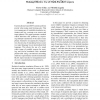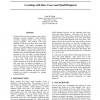662 search results - page 6 / 133 » Making inferences with small numbers of training sets |
EMNLP
2007
13 years 9 months ago
2007
We achieved a state of the art performance in statistical machine translation by using a large number of features with an online large-margin training algorithm. The millions of p...
ACL
2007
13 years 9 months ago
2007
Current phrase-based SMT systems perform poorly when using small training sets. This is a consequence of unreliable translation estimates and low coverage over source and target p...
NIPS
2008
13 years 9 months ago
2008
Neuroimaging datasets often have a very large number of voxels and a very small number of training cases, which means that overfitting of models for this data can become a very se...
KCAP
2009
ACM
14 years 2 months ago
2009
ACM
The extensive work on Knowledge Engineering in the 1990s has resulted in a systematic analysis of task-types, and the corresponding problem solving methods that can be deployed fo...
ICML
1995
IEEE
13 years 11 months ago
1995
IEEE
Systems that learn from examples often create a disjunctive concept definition. Small disjuncts are those disjuncts which cover only a few training examples. The problem with sma...


